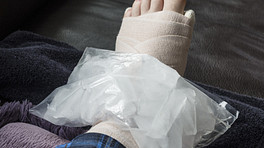Ever since it started gaining visibility on the bodies of Olympic and professional athletes, many people have been curious about the possible benefits of kinesiology tape, or kinesio tape for short.
Do those brightly colored strips of tape help athletes by preventing musculoskeletal pain or treating injuries? Can they help me too?
Research is still ongoing, but most studies so far point to the answer: Probably not. Or, at least, no more so than any other means of pain reduction for sports injuries.
Kinesio tape vs. regular athletic tape
The standard white athletic tape that athletes and trainers have used for decades is made from stiff cotton that can help immobilize or stabilize an injured body part. Kinesio tape, however, has polymer elastic strands woven through the cotton, so the tape is flexible and doesn't impede range of motion when it's applied.
Despite its flexibility, Kinesio tape is supposed to stabilize muscles and give the athlete awareness of muscle engagement, known as proprioception. In addition, some claim that it slightly lifts the skin away from the muscle, which is supposed to help reduce swelling and promote blood flow to the muscle.
Kinesio tape manufacturers and health professionals offer taping suggestions to prevent or treat injuries such as the following:
- IT band injuries
- Shin splints
- Hamstring injuries
- Achilles tendonitis
- Plantar fasciitis
- Rotator cuff
- Tennis elbow
Testing the claims of kinesio tape
However, research has failed to back these claims—or at least most of them. In 2 systematic reviews that looked at a combined total of 18 studies on the effectiveness of Kinesio tape, 6 to 7 studies indicated there may be some moderate benefits for immediate musculoskeletal pain by using kinesio tape. 1 A systematic review of the effectiveness of kinesio taping for musculoskeletal injury. Phys Sportsmed. 2012 Nov;40(4):33-40. doi: 10.3810/psm.2012.11.1986. , 2 A systematic review of the effectiveness of Kinesio Taping--fact or fashion? Eur J Phys Rehabil Med. 2013 Oct;49(5):699-709. Epub 2013 Apr 5.
None of the studies showed any significant benefits regarding long-term pain alleviation, or improved strength or range of motion. The authors of both reviews concluded that there is insufficient evidence to support the use of kinesio tape to prevent or treat injuries, or to improve strength or range of motion.
Despite this, many experts believe that kinesio tape may have a positive effect psychologically. Anecdotal evidence of its abilities may reflect a placebo effect it has on users—if people believe it's helping them, it may actually do so.
If you are concerned about treating a sports injury, your best bet is to visit our Treatment section to read doctor-authored advice for individual injuries.
Learn more:
Treating Acute Sports and Exercise Injuries in the First 24 to 72 Hours
- 1 A systematic review of the effectiveness of kinesio taping for musculoskeletal injury. Phys Sportsmed. 2012 Nov;40(4):33-40. doi: 10.3810/psm.2012.11.1986.
- 2 A systematic review of the effectiveness of Kinesio Taping--fact or fashion? Eur J Phys Rehabil Med. 2013 Oct;49(5):699-709. Epub 2013 Apr 5.








